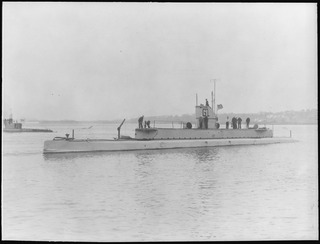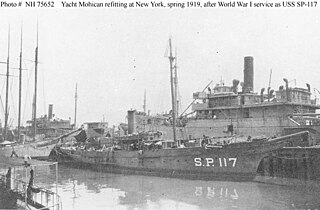Fifteen ships of the Royal Navy have been named HMS Enterprise while another was planned:

USS G-1 (SS-19½) was the lead ship of her class of submarine of the United States Navy. While the four G-boats were nominally all of a class, they differed enough in significant details that they are sometimes considered to be four unique boats, each in a class by herself.
USS Grayling has been the name of more than one United States Navy ship, and may refer to:

The New York Shipbuilding Corporation was an American shipbuilding company that operated from 1899 to 1968, ultimately completing more than 500 vessels for the U.S. Navy, the United States Merchant Marine, the United States Coast Guard, and other maritime concerns. At its peak during World War II, NYSB was the largest and most productive shipyard in the world. Its best-known vessels include the destroyer USS Reuben James (DD-245), the cruiser USS Indianapolis (CA-35), the aircraft carrier USS Kitty Hawk (CV-63), the nuclear-powered cargo ship NS Savannah, and a quartet of cargo-passenger liners nicknamed the Four Aces.
USS Niagara may refer to:

USS Narada (SP-161) was a steam yacht that served in the United States Navy as a patrol vessel from 1917 to 1919.
USS Mingo or Mingoe may refer to the following vessels of the United States Navy:

USS Fulton (AS-1) was constructed as a submarine tender in 1914, but later was converted into a gunboat and redesignated PG-49.

Demologos was the first warship to be propelled by a steam engine. She was a wooden floating battery built to defend New York Harbor from the Royal Navy during the War of 1812. The vessel was designed to a unique pattern by Robert Fulton, and was renamed Fulton after his death. Because of the prompt end of the war, Demologos never saw action, and no other ship like her was built.
Five ships of the United States Navy have borne the name USS Fulton, in honor of Robert Fulton.

USS Fulton was a steamer that served the U.S. Navy prior to the American Civil War, and was recommissioned in time to see service in that war. However, her participation was limited to being captured by Confederate forces in the port of Pensacola, Florida, at the outbreak of war.
The Allaire Iron Works was a leading 19th-century American marine engineering company based in New York City. Founded in 1816 by engineer and philanthropist James P. Allaire, the Allaire Works was one of the world's first companies dedicated to the construction of marine steam engines, supplying the engines for more than 50% of all the early steamships built in the United States.

The third USS Mohican (SP-117), later USS SP-117, was an armed yacht that served in the United States Navy as a patrol vessel from 1917 to 1919.

The fourth USS Fulton (SP-247), later USS SP-247, was a commercial tug built in 1909. She was commissioned by the United States Navy and served as a minesweeper in 1917 in the Third Naval District and returned to her previous owners two years later. She remained in service, latterly as Catherine Carroll, at least into the 1960s.
The following index is provided as an overview of and topical guide to Wikipedia's articles on recreational dive sites. The level of coverage may vary:

Recreational dive sites are specific places that recreational scuba divers go to enjoy the underwater environment or for training purposes. They include technical diving sites beyond the range generally accepted for recreational diving. In this context all diving done for recreational purposes is included. Professional diving tends to be done where the job is, and with the exception of diver training and leading groups of recreational divers, does not generally occur at specific sites chosen for their easy access, pleasant conditions or interesting features.
This page is based on this
Wikipedia article Text is available under the
CC BY-SA 4.0 license; additional terms may apply.
Images, videos and audio are available under their respective licenses.







